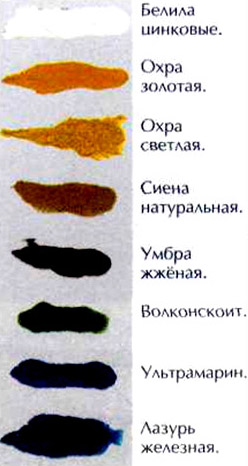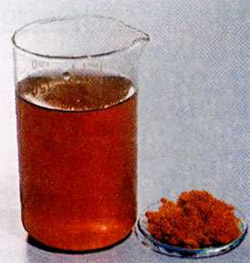



Paints are more General, inaccurate title of colored substances (pigments, dyes). The paints are suspensions of pigments in the film-forming substances and are used as protective and decorative coatings, as well as fine art. They contain fillers, solvents, plasticizers,hardeners.
The first dye that was applied as dye - soot. Chalk and ochre became known around 30 thousand years ago. About 6 thousand years ago, malachite, lapis lazuli and cinnabar began to use as pigments. In the V century BC, they were joined also white lead, red lead, litharge.
The original drawings were created using only the pigments - finely comminuted solid colored substances. Later in their composition began to enter the binder (the blood of animals, egg yolk), thus obtaining paints. To have survived image, Dating back hundreds and even thousands of years - and it's all thanks to the durability mineral paints. An extensive group of natural pigments are ochre (from Greek "KROS" - "light", "yellow"). Chemical paint composition includes hydrated (including the chemical composition of water) iron oxides (Fe2O3•H2O; Fe2O3•3H2O). During annealing ochre loses crystallization water, and the pigment becomes red dye. In our time ochre used in the production of rubber, cement, paper, plastics, however, they are gradually replacing synthetic yellow iron pigments.
If paint composition consists of minerals containing manganese oxides, the resulting dye has a brown color (remember when long stand manganese, the solution gradually becomes brown due to the presence of manganese oxide MnO2). These pigments are called Umbra.
Pigment dark red - iron minium is iron oxide (III) with admixtures of aluminum silicate and quartz. The minium - pigment versatile, resistant to light, so it is widely used for painting of wooden and metal objects, and cement.
In ancient times, natural mineral blue lapis (or lapis lazuli) Na3Ca[AlSiO4]3S valued more than gold. Paint is done from this powder of stone was called ultramarine. Later by injection of kaolin with sodium carbonate and sulfur (or sodium sulfate and coal) have been getting artificial ultramarine. Chemical paint composition "ultramarine" is Na8Al6Si6O24S. Another well-known mineral paint synthetic origin - "Prussian blue" K[FeIIFeIII(CN)6], first obtained in 1704.
As a green pigment for a long time used the so-called Bohemian earth - mineral augite (Ca, Na) (Mg, Fe2+ and Fe3+, Al, Ti) [(Si, Al)2O6]. Then began to prepare paints oxide chromium(III) and its hydrate. Phthalocyanines chrome dyes, that were opended in the 30-ies of XX century, were almost superseded by them.
White pigments comprise more than 60% of all modern pigments. They are used for the manufacture of paints, not only white but also other colors, plastics, paper, building materials, ceramics, etc. White lead widely used in ancient times, - basic lead carbonate 2Pb CO3 • Pb (OH)2. For many centuries, people did not know anything about the toxicity of lead, so lead white were part of some cosmetics.,
Now white lead almost completely replaced by titanium dioxide, zinc oxide (ZnO), lithopone (a mixture of zinc sulfide and barium sulfate). Paint pigments, which do not have widespread, may be used in the art paints due to the high cost of cobalt paints or because of toxicity, sulfides of cadmium and mercury.When mixing pigments with plant glues (wheat starch, dextrin, etc.) are prepared watercolors (from Lat. Aqua – «water») - paint arebred water. If the white paint add to pigment-adhesive mixture, the paint layer is more dense. These paints are called gouache (from IT. Guazzo - «waterpaint»).
Oil paints are prepared and based on vegetable oils or synthetic resins. In addition to mineral paints in ancient times were widely used paint plant and animal origin. They have a lot of colors, but much less durable.As the dyes have long time been used buckthorn juice, saffron, blueberries, mignonette, extracts from the bark of oak, alder. Favorite paint Roman nobility is purple glands was extracted from the Mediterranean mollusk Muricidae.These mollusks were crushed and the juice used for soakcloth. This juice acquired purple in the air. However, clothing fabric the same color were available only to patricians: for 1 g of this dye required to crush and process more than 8 thousand Mollusks.Appreciated as carmine paint (cochineal) extracted from carmine bugs. 200 thousand of bugs given only 1 g colorant. Another paint - indigo was got Europe from India. Initially, it was got from the leaves of indigofers.
100 kg of leaves output 3 kg of indigo."Aniline red" or magenta (from the name of a red flower fuchsia) was succeed synthesized in the middle of the XIX. When heated aniline C6H5NH2 in a sealed tube with СH2Cl-dichloroethane СH2Сl turned red substance coloring silk and wool.It was also got a reddish-purple substance, later named mauveine (from the French. Mauve - «mallow") for its resemblance to the color of flowers mallows. Industrial production of mauveine was the beginning of aniline industry. Production of azo dyes begen after opening the British chemist Peter Grissom in 1857 diazotization reaction/ It was the most numerous class of organic dyes.
Gries discovered if treataromatic amines with nitrous acid then formed the unstable diazonium salt, as a result of interaction it with some compounds (phenols, aromatic amines) appear colored products: however, despite the impressive advances of the industrial synthesis of dyes, Indigo is still received in the traditional way - from plant raw materials. In 1866 to study the "king of dyes" started Adolf Bayer. He was able to establish the molecular structure of the substance and in the 80s to establish it laboratory synthesis. And only at the end of 90-ies of the XIX century began the industrial production of Indigo.
By the beginning of XX century were received more than 1,200 synthetic organic dyes. Unfortunately, their production and today remains one of the most polluting the environment, so now the research in this area is aimed not to finding new dyes, but to the improvement of already known technologies. The structure of modern paints complex. In addition to the pigment and film-forming substance the paint composition may include solvents, thinners, driers (substances that accelerate the drying of paints and varnishes) and other auxiliary components. Depending on the type of film-forming substances paints are divided as follows: oil paint, enamel paint, emulsion paint and powder paint.
Oil paint produce on the basis of drying oils - polymerized plant oils (flax, hemp) or liquid alkyd resins.
Enamel are suspended finely ground pigments in solutions varnishes - film-forming substances. The so-called emulsion paint is produced based on aqueous dispersions of polymers, such as polyvinyl acetate, polyacrylates, and powder paint is on the basis of dry polymers (polyethylene, polyvinyl chloride and others) that form solid film coating when heated to a certain temperature.
Every year the world produces about 10 million tons of paint and varnish materials. This amount would be enough to cover the Earth at the equator colorful belt with a width of 2.5 km. About the explosive properties of nitrocellulose is known to almost every student. But not everyone knows that its application is started by overproduction of explosives after the First world war in the auto industry. When was successfully solved the problem of disposal of dangerous substances (nitrocellulose) and started the production of paints and lacquers on basis of nitrocellulose for painting auto bodies.